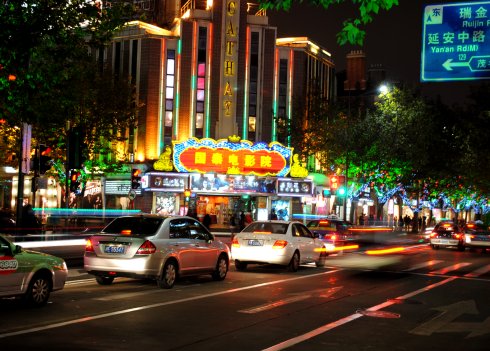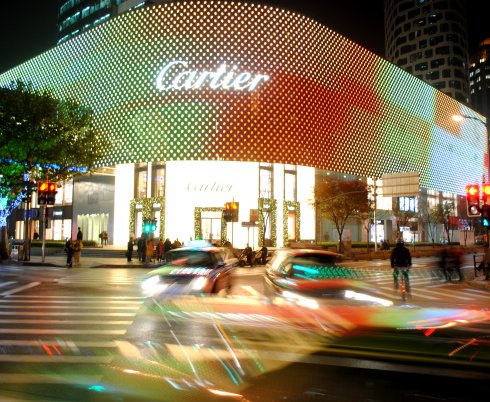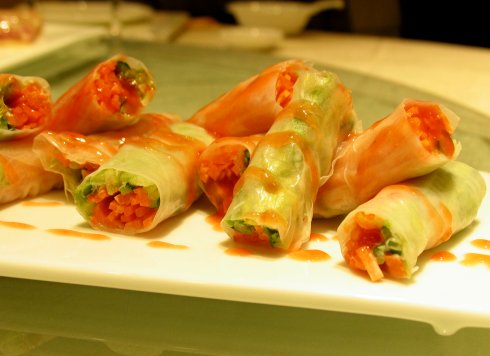
Dinner in Shanghai that is about ten hours by direct flight from Sweden.
Text and Photo © PO Larsson and CM Cordeiro 2012
Shanghai’s changing cityscape is reminiscent of the changing skyline of Singapore, where every time I visit I find myself looking at a skyline that is augmented in some manner especially in Lujiazui, which also most reminds me of the Singapore quiet in the Central Business District by Raffles Quay by night.

Shanghai by night.
Shanghai by night is an amazing display of city lights and movement. Whether walking about town or in a taxi on your way from one place to another, you’ll find yourself surrounded by neon displays of information flow in lights. The city hardly sleeps.
But that the city hardly sleeps is both a metaphor and a reality for the Chinese economy at large. Being in Shanghai often enough, I find myself experiencing the dynamism and spending power of China’s nouveau riche. You witness first hand, as you walk into department stores, how the news had only reported in words, that in the global recession of 2009, Chinese luxury goods saw a 16% increase in sales from previous years or that power luxury houses such as Louis Vuitton, Hermes, Gucci, Armani, Cartier, Tiffany etc have since 2005, more than tripled their number of outlets in China, without even attempting to move inland as yet. And as the taxi turns the corner and Cartier flashes in your direction in a myriad of dazzling colours, its walls crystal studded and promising, you too become mesmerized not just by the raw statistics but by the reality of the growing affluence in China today.

Cartier in dazzling display in Shanghai.
In Confucian and paternalistic China, some interesting points in this entire context of the Chinese consumer market in general include the fact that the Chinese government’s policies themselves spur investment that in turn fuel the capacity for consumption by the Chinese people. Policies such as tax rebates, urging large state-owned enterprises expand inland, that will in turn encourage other enterprises to follow suit, heavy investment in own research and development, building upon their human capital expertise and by raising the minimum wage with the aim of overall increasing household disposable income by 7% a year all encourage an upward trend of not just consumption but consumption of luxury goods. About half of wealthy Chinese today were not just four years ago and in the next five years, more will be wealthy where they are not today.
In literature review from McKinsey China, their research indicated that China’s wealthy households that have spending power of about USD 100,000 a year hit 1.6 million in 2008 and is expected to be more than 4.4 million in the next three short years by 2015.
But it isn’t only that China is able to afford goods today far beyond the basics of clean water, a proper mattress to sleep on and electricity to the homes but rather that in all of this, a process of paradigm shift in the attitudes towards how and where money is spent is also taking place in Chinese consumers.

Chinese consumers today would go beyond functionality and basics of the product to connecting with it, emotions and experiences of a quality life and good living.
Where once there was a preference for external and ostentatious goods with as much bling-effect as possible that showed you had money, these days a greater sense of sophistication follows Chinese consumer tastes with the want products with less obvious branding. Beyond practicality and functionality of the product comes the emotions and experiences that the consumer can associate with the product and its brand. Chinese consumers today are also as likely to spend money on a product that makes them feel unique, setting them apart from the socio-cultural group that is extremely Confucian ingrained. And where once most luxury products were purchased abroad not only because of its exclusivity but because therein lies the implied message that they could afford the travel costs involved in acquiring the product, today they would buy luxury goods in China, based on emotion branding.
Personally, I can’t help but be interested in the automobile industry in China. Since 2004, the Chinese “car-culture” has taken steady pace of growing interest where the past five years saw a mushrooming of car clubs across the major cities in China. The concept of driving in itself deliver the very idea of freedom; freedom to move, freedom from tight city spaces, freedom from scheduled meetings all day and freedom even from strict socio-cultural norms.
This shift of paradigm in consumer attitudes from practical to ideal that has occurred even in automobiles as a product, has of course captured the interest of the global auto-industry. After all, according to Project Syndicate, China became the world’s top car market in 2010 in the midst of when other more developed countries struggled with their ‘global recession’.
This shift in paradigm in consumer mentality is a dialogic process. In most change processes, there exists a certain extent of malleability where influence of patterns of behavior and thought are exchanged between forces rather than simply absorbed, set and perpetuated. So in as much as research often ponders and focuses on the importance of understanding the consumer’s point of view, their latest likes and dislikes and where next would they put their money, large multinationals and luxury powerhouses have in as much, the power to influence Chinese consumer tastes, behavior and ultimately, brand loyalty.
Riding on the wave of this change of mindset many car companies is set to cater to the tastes of Chinese consumers. Dagens Industry with their China based journalist Jenny Hedelin reported in their print version on 20th February that Volvo Car Corporation aims to increase sales while the automobile industry in general takes a slight slump in 2011 and 2012. In an interview in China, President and CEO of Volvo Cars Corporation Stefan Jacoby said that they intend to do this by increasing sales in China by 25% this year, a move that will be accompanied by the hiring of another 10,000 persons in China. And they will do this by positioning Volvo Cars as a luxury item in the automobile industry, catering not only to the private sector but also in taking a larger share of government service cars.
But while positioning Volvo as a luxury brand in China, more interesting is that Volvo will launch mini-cars too (DN.SE 2012-02-23 11:07), albeit their target group for this new line of mini-cars goes beyond China, to include Brazil and India. Smaller than today’s C30 and V40 models, this line of mini-cars will cater to individuals and families who want to call that bit of luxury their own and be associated to all emotions and experiences connected with that brand.
My personal reflection in all this, is that Volvo Car’s move into mini-cars might also have an impact that is perhaps unreflected upon at the moment – as in gender spending in China. Laurie Burkitt for Wall Street Journal reported back in 2011 that women have emerged as a growing consumer luxury force and that brands that traditionally appeal to women are making a bigger push. This is backed by research from McKinsey China, for the moment, three-quarters of Chinese women say that they are the ones who control the family purse strings, spending on everything from household food to interior decoration, to homes. Men on the other hand tend to spend on larger ticket items such as cars and houses. With Volvo Cars new mini-car line, a shift in the dynamics of gender spending might well be underway, allowing them to tap into the “emerging powerhouse within the powerhouse of China” where (ref. Isaac Stone Fish, “Chinese women go shopping”, McKinsey China) and in the near future Chinese women will just go out and buy their own cars.
Seeing that Volvo Cars is headquartered in Shanghai together with its Volvo Car China Technology Centre there, the idea of mini-cars as luxury on the streets supported potentially in the very near future by a mainly female consumer base will certainly continue to put Shanghai’s metaphor of a city that never sleeps into new perspective, providing base insight into China’s consumer culture as a whole.
————–oOo————–
Bibiography
LI, Chen, Brand culture and consumption in china, Doctorante en science de gestion, GREFI. Université d’Aix- Marseille III
Wall Street Journal for “China and luxury”